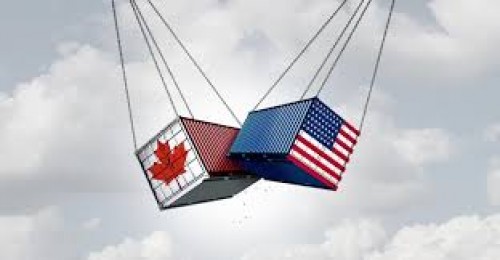Best Source for B2B Industry Trends, News and Updates

Speaking at a press briefing, Trump cited multiple concerns, including Canada’s alleged role in cross-border fentanyl trafficking, “extraordinary” dairy tariffs, and what he called a “massive” trade imbalance, pointing to a$63billion U.S. trade deficit with Canada in 2024. The tariff will affect Canadian imports not protected under the United States-Mexico-Canada Agreement (USMCA), which remains unchanged. Trump noted that the new 35% tariff is a response to unfair trade practices and a failure by Ottawa to meet U.S. security and economic concerns.
Sector-specific duties, including 50% on steel and aluminum, 25% on non-USMCA automobiles, and 10% on energy and fertilizer imports, will remain in place. These measures are part of a broader strategy aimed at reshaping trade relations with key global partners.
The former president warned that any retaliatory measures from Canada would be met with further increases. “If Canada hits back, the 35% can quickly become 45% or more,” Trump said. He also threatened to raise baseline tariffs on most other countries from the current 10% to 15–20%, citing unfinished trade negotiations and what he described as “non-reciprocal” trade terms.
The tariff hike is part of Trump’s renewed “reciprocal tariffs” campaign, which has already seen notification letters sent to over 20 countries, including Japan, South Korea, Brazil, and EU member states. Brazil, in particular, is facing a proposed 50% tariff in response to what Trump described as worsening political relations.
Canadian Prime Minister Mark Carney responded by emphasizing Canada’s commitment to stopping the flow of illegal fentanyl and reiterated a willingness to negotiate before the new tariffs take effect. Canada, in a bid to ease tensions, has paused planned retaliatory tariffs on U.S. steel and aluminum imports, which were originally scheduled to double by the end of July. “We believe diplomacy should come before economic warfare,” Carney stated during a press appearance, signaling hopes that a solution could be reached before the August 1 deadline.
Markets reacted quickly to the news. The S&P 500 slipped by 0.3%, while the Dow Jones Industrial Average dropped 0.6% as investors grew concerned about inflationary pressures and disrupted trade flows. Canadian markets were also affected, with the TSX futures declining and the Canadian dollar weakening by about 0.2%. The European Union, closely monitoring the situation, is reportedly preparing its own trade measures in anticipation of potential tariff expansion by the U.S.
This latest move underscores the uncertainty in global trade relations as the U.S. moves toward a more protectionist stance. The 35% tariff on Canadian goods not covered by USMCA highlights the ongoing volatility in North American trade policy and raises questions about the long-term stability of the trilateral agreement signed in 2020. Economists warn that higher import duties could drive up consumer prices and disrupt manufacturing supply chains across the continent.
According to Reuters, Trump’s tariff strategy is part of a broader plan to leverage U.S. market access in exchange for concessions from trading partners. TIME reported that despite claims of a $63 billion trade deficit, many analysts argue the trade balance with Canada has historically fluctuated and often includes significant U.S. surpluses in services and energy exports (source). Politico noted that Canada’s decision to hold off on retaliation for now is a sign that Ottawa wants to avoid a full-scale trade war while keeping the door open for resolution through negotiation (source).
With less than three weeks to go until the tariffs take effect, both sides face increasing pressure from domestic industries and international observers to resolve the conflict. The coming days may prove decisive in determining whether this latest trade dispute can be resolved diplomatically or if it will mark the beginning of a broader protectionist shift in U.S. economic policy.
